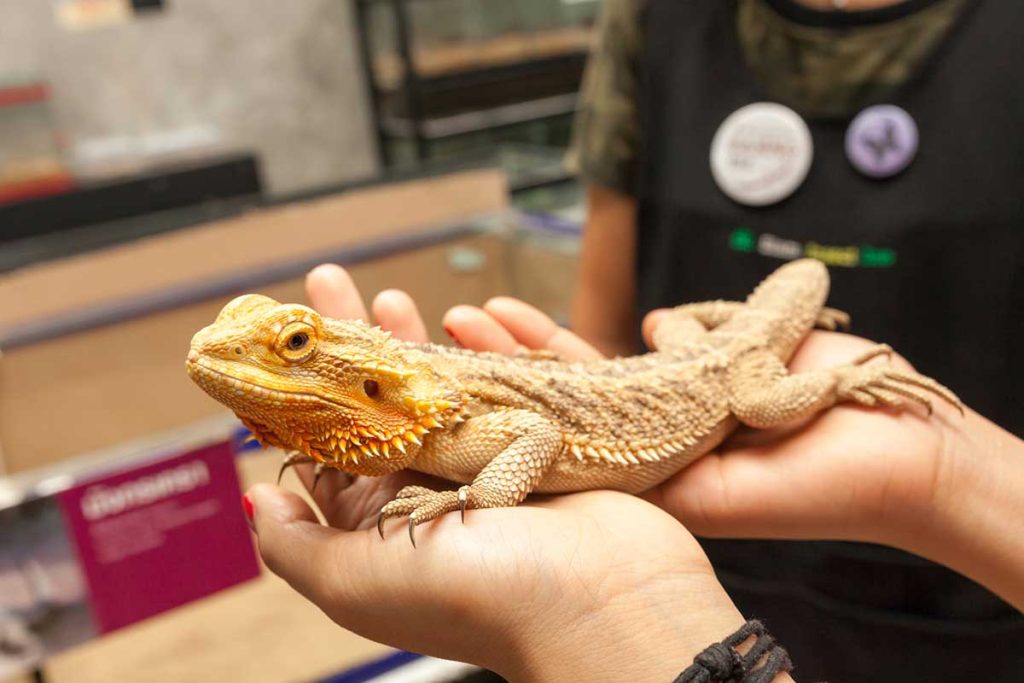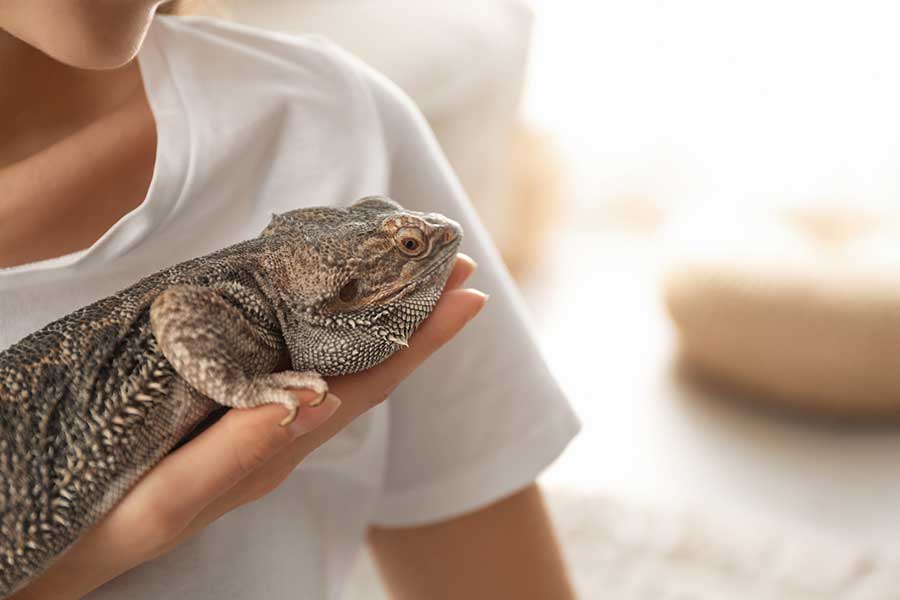You may have seen your bearded dragon bob its head or sway while you are playing music. Alternatively, you may have seen them run away when a song changes! This odd behavior may have led you to wonder: do bearded dragons like music?
To put it simply, sounds are vibrations at different frequencies. Music, then, is just a bunch of sounds put together in a pleasing way. Bearded dragons pick up on vibrations very well in a certain frequency range. Therefore, they could very well have their own taste in music!
Using music as a tool, you can stimulate and enrich your bearded dragon’s surroundings. However, not all bearded dragons like music, so pay careful attention to how they react and either adjust the type of music you are playing or remove it all together.
What Is Music, and Can Bearded Dragons Hear It?
Music is a collection of vibrations strung together in a pleasing way. Music can be played at different volumes and at different frequencies.
There is a significant amount of research that has gone into the study of what types of music and frequencies benefit humans the most, but how do these different genres and frequencies affect bearded dragons?
To figure out your bearded dragon’s playlist, you first need to understand how they hear and appreciate sound. They do have ear holes and can hear it, after all–and they pick up on music’s vibrations in their own unique way, too.
How Do Bearded Dragons Interpret Music?
As we touched on above, bearded dragons have ears at the base of their skulls. They are very little, but they are definitely there! Now let’s get into how bearded dragons hear.
The middle ear is made up of the tympanic membrane (ear drum) and stapes (small bone). The pressure from the force of sound waves causes the tympanic membrane to vibrate, which moves the stapes.
The inner ear is made up of the end of the stapes, the foramen ovale (hole in the skull), interconnected hollow canals containing tubes, and the eustachian tube (connection to the throat). The stapes move against the foramen ovale, which transmits the vibrations to the fluid-filled tubes.
The vibrations in the tubes are then decoded by the brain. The brain provides meaning to the vibrations. For humans, this translates into words, music, the sound of a car alarm, or a baby crying; all of these things are recognizable to us.
For bearded dragons, the vibrations are decoded into the sounds of a cricket moving, the wing beats of a bird, the yowl of a cat, or the sound of running water. All of these things are important to their survival to indicate where they will get their next meal or when a predator is near.
What Kind of Music Does My Bearded Dragon Like?
Bearded dragons can pick up frequencies from 500 to 4,000 hertz. Humans can generally hear from 20 hertz to 20,000 hertz or 20 kilohertz. Our range of hearing is significantly wider than bearded dragons, so keep this in mind when you think your beardie may be ignoring you!
500 hertz sounds like this, whereas 4,000 hertz sounds like this. It is easy to hear, even as a human, how music with a lower frequency may be more calming and better on the ears for bearded dragons and how music at 4,000 hertz may cause them to be distressed.
When playing music for your bearded dragon, make sure it is tuned to the lower end of their frequency range to make sure that they can hear all of it and it is calming. After you have figured out the frequency that they prefer, get to the genres!
Different bearded dragons have different tastes in music, so picking their favorite songs and genres will take some trial and error.
Creating the Ultimate Bearded Dragon Playlist!
Get a small speaker that connects to your phone or device that plays music and turn the volume all the way down. Choose the piece of music you want to play for your bearded dragon. Place the speaker in the enclosure near your bearded dragon and hit play.
If your bearded dragon sticks around, you can increase the volume slightly but not by a lot. Bearded dragons are very small, and their enclosure will amplify the sound of the speaker.
Let the music play for a minute or two before changing to the next track. Note any difference in behavior from your bearded dragon as this will tell you what they like and what they dislike. Do not cycle through the music very quickly or change from genres often, as this may disturb them.
If you wish to set up their own disco station to enjoy from time to time instead of having the speaker inside of their enclosure, then follow these steps:
- Get a plastic bin, roughly the size of their enclosure (you can use their bathing or swimming tub)
- Lay a blanket down along the bottom of the tub. It is important that it covers the sizes of the tub as well.
- Place the speaker at one end of the tub and start playing the music.
- Put your bearded dragon in the other end of the tub and watch what they do.
The blanket is an important element to include in the tub. The fabric will absorb some of the vibrations so that they do not bounce off of the sides of the tub and cause your bearded dragon stress.
Signs Your Bearded Dragon Likes Music
If your bearded dragon is enjoying your musical stylings, they may do a couple of things. They may sit with their mouths open and relax or they may sit close to their speaker and bob their heads.
If they do not enjoy the music, they will run away and hide to try and decrease the amount of noise they are hearing. Alternatively, they may darken their skin, stomp their feet, and hiss.
Be very aware of any changes in your bearded dragon’s mood and react accordingly.
What Genres Do Bearded Dragons Like?
Bearded dragons like music that is slower-paced. This means your beardie may be a huge blues, classical music, or slowcore alternative rock fan.
Look for music that is calming to you but has a steady beat, and your bearded dragon should enjoy it. Popular music pieces are also the tracks that DJs use to warm up and cool down a crowd before they really get into the heavy stuff.
Try out different types of music and different types of genres until you build up your bearded dragon’s top playlist!
Can Music Be Dangerous to Bearded Dragons?
As with humans, too much of a good thing can be bad for your bearded dragon’s health.
Music inside of the enclosure should be limited to 30 minutes maximum a day. The constant vibrations in the enclosure can become overwhelming for your bearded dragon, and this may lead to stress and stressful behaviors such as arm waving and glass surfing.
If the music is too loud, then your bearded dragon’s hearing can become damaged just like human hearing! When music is too loud, the tympanic membrane (eardrum) has to work overtime to absorb all of the vibrations and changes in pressure, which means it can wear itself out.
Additionally, if the music has too much bass or pops loudly, the pressure on the tympanic membrane can cause it to rupture.
What Are Some of the Most Popular Songs That Bearded Dragons Like?
These are some recommended songs for bearded dragons based on the fact that they are widely considered to be calming and have a slower, more relaxing tempo:
- Electra by Airstream
- Watermark by Enya
- Someone Like You by Adele
- Pure Shores by All Saints
- Strawberry Swing by Coldplay
- Ocean Eyes by Billie Eilish
- Rêverie by Debussy
- Moonlight Sonata (first movement) by Beethoven
- Peace Piece by Bill Evans
- Air (On a G String) by Bach
At the Tail End of Things…
Most bearded dragons like music every now and then when it is played at a comfortable level, in the right frequency range, and is not overwhelming to them.
Bearded dragons hear sounds at a much smaller frequency range than humans do, which means they do not hear everything that you hear. However, they are very sensitive to what they can hear.
Playing music is a great way to calm your bearded dragon, engage their intelligent side, and enrich their surroundings if it is done in the right way. Remember to always keep the volume down and to have something around them that will absorb excess vibrations.
Too much music or too loud music will cause your bearded dragon stress, so limit their rave time to 30 minutes a day at a low volume. Watch them for their reactions, and have fun creating their personalized playlist!




